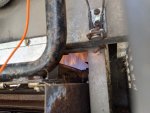Hi everyone!
EDIT: Wow, I apologize in advance for the wall of text.
We bought a pool equipped house that was in a deep (deep) state of disrepair - pool included. I've been chipping away at issues pretty steadily, making learning and repairing the small pool my hobby. Its a very small unit, more of a sim spa than a pool. By my calculations its only about 2800 gallons. Before I get to the issues, let me try and give an idea of the entire system:
I went to turn it on three days ago and no luck. I've followed what troubleshooting processes I've been able to find, but I do not have an original manual for the unit and it's so old that there don't seem to be copies available online for this specific model/vintage. The reference material I've found is for newer versions of this model and while it helps, it isn't exact. I think the issues this time are rooted in the gas valve, but I'd like to run that by you folks as a bit of a sanity check.
Specifically, the heater igniter sparks, and the pilot lights on a call for heat from the controller. But nothing else happens. When the heater switch is turned on at the control panel I can hear a click from what I suspect is the pilot solenoid, the pilot lights and the igniter begins to spark...and never stops until the heater is disabled.
I checked the flame sensor thermocouple and I'm getting somewhere in the vicinity of 500mV when exposed to a differential, which checks against a brand new unit. I figure the control unit is working fine if the iginiter is sparking in the first place, ditto for the remaining components of the safety loop. I checked the gas valve at terminal TR, looking for 24V and it checks out okay.
In my reading here I've noted that I should get a whiff of natural gas on startup. That definitely doesn't happen. I don't have a manometer to check for gas output pressure, though I suppose that's the next step. By now I think I have enough data points to call the gas valve bad, but its $200 at the cheapest. I'd love a second of opinion if anyone can think of anything else.
This site is awesome.
EDIT: Wow, I apologize in advance for the wall of text.
We bought a pool equipped house that was in a deep (deep) state of disrepair - pool included. I've been chipping away at issues pretty steadily, making learning and repairing the small pool my hobby. Its a very small unit, more of a sim spa than a pool. By my calculations its only about 2800 gallons. Before I get to the issues, let me try and give an idea of the entire system:
- Rectangular, approx 4 feet deep pool/spa area
- Three pumps (none variable speed).
- Filter
- Swim Jets
- Spa jets
- Cartridge filter
- Easytouch upgrade automation
- One (ancient) Hayward electronic ignition heater. I don't have a date of manufacture, but this thing must be from when the pool was originally installed, which in my estimation was sometime in the mid-90's.
I went to turn it on three days ago and no luck. I've followed what troubleshooting processes I've been able to find, but I do not have an original manual for the unit and it's so old that there don't seem to be copies available online for this specific model/vintage. The reference material I've found is for newer versions of this model and while it helps, it isn't exact. I think the issues this time are rooted in the gas valve, but I'd like to run that by you folks as a bit of a sanity check.
Specifically, the heater igniter sparks, and the pilot lights on a call for heat from the controller. But nothing else happens. When the heater switch is turned on at the control panel I can hear a click from what I suspect is the pilot solenoid, the pilot lights and the igniter begins to spark...and never stops until the heater is disabled.
I checked the flame sensor thermocouple and I'm getting somewhere in the vicinity of 500mV when exposed to a differential, which checks against a brand new unit. I figure the control unit is working fine if the iginiter is sparking in the first place, ditto for the remaining components of the safety loop. I checked the gas valve at terminal TR, looking for 24V and it checks out okay.
In my reading here I've noted that I should get a whiff of natural gas on startup. That definitely doesn't happen. I don't have a manometer to check for gas output pressure, though I suppose that's the next step. By now I think I have enough data points to call the gas valve bad, but its $200 at the cheapest. I'd love a second of opinion if anyone can think of anything else.
This site is awesome.
Last edited:








